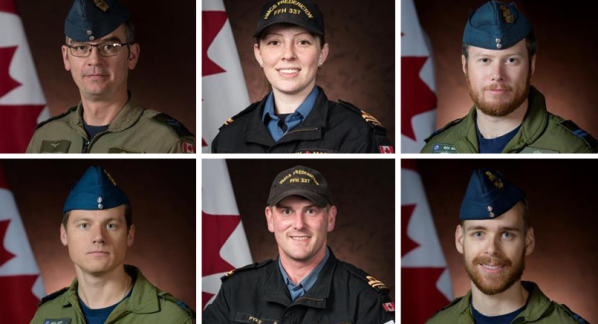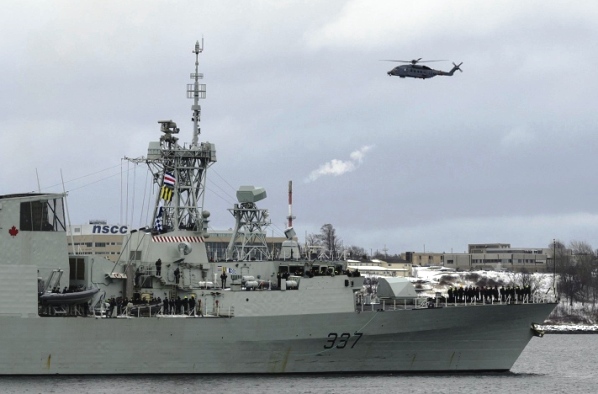|
29.04.2020
Ionian Sea, about 85km from the Island of
Cephalonia - Greece
 From
top left: Master Cpl. Matthew Cousins, Sub-Lt. Abbigail Cowbrough and
Capt. Brenden Ian MacDonald. From bottom left: Capt. Kevin Hagen,
Sub-Lt. Matthew Pyke and Capt. Maxime Miron-Morin. (Credit: Department
of National Defence) From
top left: Master Cpl. Matthew Cousins, Sub-Lt. Abbigail Cowbrough and
Capt. Brenden Ian MacDonald. From bottom left: Capt. Kevin Hagen,
Sub-Lt. Matthew Pyke and Capt. Maxime Miron-Morin. (Credit: Department
of National Defence)
An RCAF Sikorsky CH-148 Cyclone (S-92)
helicopter (148822), operating by 12 Wing, from HMCS Fredericton
(FH337), a Halifax-class frigate, crashed into the Ionian Sea. The area
of the accident falls within Roma FIR and the SAR mission is carried out
by the Italain Authorities. One body was found and five occupants were
missing.
The Canadian Armed
Forces confirmed the death of one sailor, Sub-Lt.
Abbigail Cowbrough of Nova Scotia, as the identities of the five
missing crew members:
• Capt. Brenden
Ian MacDonald from New Glasgow, N.S.
• Capt. Kevin Hagen from Nanaimo, B.C.
• Capt. Maxime Miron-Morin, from
Trois-Rivieres, Que.
• Sub-Lt. Matthew Pyke from Truro, N.S.
• Master Cpl. Matthew Cousins from Guelph,
Ont.
The helicopter was flying from Halifax-based
naval frigate HMCS Fredericton as part of NATO’s Operation Reassurance.
The
CH-148 Cyclone lost contact during an allied exercise over the
Ionian Sea on Wednesday, 29-Apr-2020.
The Cyclones are typically deployed on board
Canadian frigates and used for search and rescue, surveillance and
anti-submarine warfare.
The CH-148 Cyclone was cutting-edge tech when it
became the Canadian military's new maritime helicopter. After a crash
killed six service members, investigators are being confronted with some
awkward questions about how ready both the machine and the military were
for fly-by-wire.
Industry experts said the digital system
opened up a world of new possibilities for flight operations and the
future of helicopter aviation in general.
That was because the U.S. manufacturer,
Sikorsky, had — at the time — never built a helicopter which didn't have
a mechanical link between the cockpit controls and the main or tail
rotors.
In the Cyclone, flight control computers do
all of the work. Unique to the Cyclone was the so-called "flight
director" mode, which is closely linked to the flight control system and
allows maritime helicopter pilots to automate search patterns, among
other things.
One aviation expert
has concerns.
"Going to a fly-by-wire
system, with no mechanical links, is
not for the faint of heart
and needs pretty detailed knowledge about software and hardware and all
of that sort of thing," said Shawn Coyle, a former Canadian military
pilot and civilian accident investigator.
There are just a few
helicopters in service around the world with that kind of technology.
They include the European-designed
NH-90 and the Bell-Boeing
V-22 Osprey.
The scarcity of fly-by-wire choppers has led
to a shortage of expertise.
"There are very few people who've done a
certification on fly-by-wire control system on a helicopter," he told.
"Doing something with software is not always
easy," he said, adding programmers don't always think "of everything."
A military
investigation has found that an autopilot issue played a major role in
the deadly crash of a Cyclone helicopter off the coast of Greece last
year.
As a pilot guided the naval helicopter into
a tight turn, a built-in autopilot took control and sent the aircraft
into the Ionian Sea, killing all six personnel on board. The process
played out even though the pilot received no training or cockpit
indicators to warn of how the automation system would respond in that
"very specific" circumstance, the Defence Department said in a release.
The crash of the
Stalker 22 on April 29, 2020,caused the worst single-day loss of life
for the Canadian Armed Forces since six soldiers were killed in a
roadside bombing in Afghanistan on July 4, 2007.
It marked the third incident involving a
Cyclone, with defective software blamed for one of the helicopters'
suddenly dropping several hundred feet during a test flight in 2017.
Another had a "hard landing" on a ship in February 2019.
Several restrictions were placed on the
helicopters after the 2017 incident forbidding crews from performing
certain manoeuvres.
The report lists several recommendations,
including the need to fill in gaps in flight training manuals, modify
flight control software and establish a working group to review
operational requirements around complex turning manoeuvres for the
CH-148 Cyclone.
The report says the
aircraft's certification did not include testing of what would happen if
a pilot overrode the autopilot more than "momentarily" while making a
tight turn to land on the flight deck in a "final complex" manoeuvre.
The helicopter's autopilot, or "flight
director," was not intended to be overridden for extended periods, the
report indicates, despite the fact that pilots "regularly" overrode the
system without manually pressing a button on their control stick, called
the cyclic.
The software issue was a key cause, but not
the only one, said Brig.-Gen. John Alexander, the flight safety director
at the Royal Canadian Air Force who authored the report.
"This accident was not the result of one
single causal factor, but a combination of several and could have
happened to any other crew on any other day," he said in a statement.
Flying publications contained information
that may have been "confusing or misleading,"included "incomplete"
sections on automation and lacked manoeuvre descriptions essential for
use in the field, the report states.
The autopilot response was "unknown to the
manufacturer, airworthiness authorities, and aircrew prior to the
accident," Alexander said.
His report follows one from Canadian Armed
Forces board of inquiry and obtained by The Canadian Press that made six
recommendations. Five involved better training for pilots to make them
aware of the potential problems that could occur if they override the
autopilot.
It also recommended creating special cockpit
signals pilots could use to warn each other about overriding flight
directors for extended periods of time. However, that suggestion is not
shared in the more recent analysis from the flight safety directorate.
The new report says pilots must be well
trained to almost instantly press a single button on their control stick
to disengage the autopilot if they're not getting the response they want
out of their controls. But automatically disengaging the autopilot might
pose its own risks in some situations, especially when a pilot believes
the autopilot will keep functioning, according to the study.
The report instead argues that the software
— and its "accumulation of these biases"— needs to be addressed by
Connecticut-based Sikorsky Aircraft, the century-old manufacturer of the
Cyclone.
Constant alertness is another
recommendation.
"Crews must guard against complacency by
remaining mentally engaged in flight operations and employ standardized
operating procedures," Alexander said in the report summary, stating
that "ineffective" crew resource management contributed to the crash.
However, it’s not as simple as making a quick
fix because changing one part of the Cyclone’s existing software could
have unintended consequences elsewhere.
This report by The
Canadian Press was first published June 28, 2021.
========================================================================================================
 В
Ионическом море потерпел крушение палубный вертолет ВМС Канады В
Ионическом море потерпел крушение палубный вертолет ВМС Канады
29.04.2020
Греция, в 46 морских милях от острова
Кефалония в Ионическом море
 20.01.2020
- Канадская фрегата HMCS Fredericton (FH337) - THE CANADIAN PRESS/
Darren Calabrese 20.01.2020
- Канадская фрегата HMCS Fredericton (FH337) - THE CANADIAN PRESS/
Darren Calabrese
В Ионическом море во время учений союзных
сил альянса потерпел крушение палубный вертолет из состава ВМС Канады.
Во время учений НАТО, примерно в 50 милях от
острова Кефалония в Ионическом море, потерпел крушение палубный вертолет
CH-148 Cyclone (148822), базировавшийся на канадском
фрегате Fredericton (FFH 337). На борту находилось
шесть человек. Известно об обнаружении тела одного
погибшего. Причина крушения является проблема в программе
автопилота.
Вертолет СН-148 – это противолодочная версия
коммерческого вертолета Sikorsky S-92, предназначенная для замены
морских вертолетов Sikorsky CH-124 Sea King. Первые вертолеты CH-148
Cyclone ВМС Канады начали получать в 2015 году.
========================================================================================================
 Хеликоптер
на НАТО се разби в Йонийско море, има загинали Хеликоптер
на НАТО се разби в Йонийско море, има загинали
29.04.2020
Гърция, на
85 км от о-в Кефалония в Йонийско море
 22.01.2020
- Вертолет CH-148 Cyclone на палубата на фрегатата "Фредериктън" (сн.
Симон Арканд/ Кан. ВС) 22.01.2020
- Вертолет CH-148 Cyclone на палубата на фрегатата "Фредериктън" (сн.
Симон Арканд/ Кан. ВС)
Хеликоптер на канадските военновъздушни сили, Sikorsky
CH-148 Cyclone (S-92) с бордови номер
148822 от 12
ав. крило към фрегатата "Фредериктън" участвал
в НАТО-вското учение "Reassurance", с шестима
души на борда, се е разбил в международните
води между Гърция и Италия. Открити са останки от вертолета, както и
тялото на мл.
лейт. Abbigail Cowbrough. Издирването на
останалите 5-ма
от екипажа е
прустановено.
Абби е девойка от Нова Скотия, Канада, известна и като талантлива
изпълнителка на гайда от състава на музикална група. Пленителна с чара и
уменията си очевидно притежава и славянски гени по линия на майка си,
която се казва Таня.
Вертолетът CH-148 Cyclone (S-92) е първият на фирмата
Sikorsky създаден по новата технология "лети
посредством жица", която изключва механична връзка между лостовете за
управление в кабината и винтовете с перки осигуряващи полета.
Технология, която до голяма степен зависи от бордовите компютри и
въведения им софтуеър. Според експерт новият метод изисква допълнителни
умения от екипажа и като цяло не е за хора със слаби сърца.
На 28.06.2021 бяха публикувани резултатите от разследването. Установява
се, че главна причина за катастрофата е бъг в
програмата (софтуеъра) на автопилота. Ако пилотът
въведе вертолета в остър завой и така се опита да преодолее зададените
инструкции и параметри на полета в автопилота, то последният отнема
контрола от екипажа и насочва машината безнадеждно към повърхността. До
катастрофата, този проблем с автопилота не е бил известен дори на
производителя.
|



